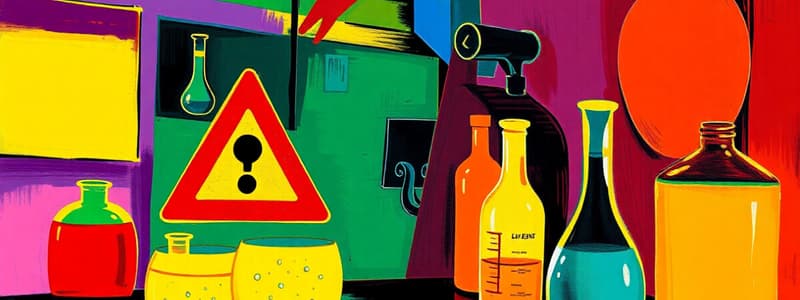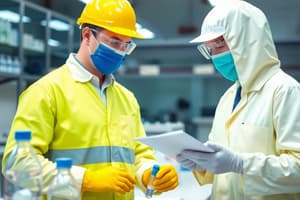Podcast
Questions and Answers
What is the primary reason for conducting risk assessments in laboratories?
What is the primary reason for conducting risk assessments in laboratories?
- To increase laboratory efficiency
- To comply with government regulations
- To safeguard employee safety (correct)
- To monitor employee productivity
Which equipment in a laboratory necessitates specific safety training due to injury risks?
Which equipment in a laboratory necessitates specific safety training due to injury risks?
- Microscopes
- Hotplates
- Autoclaves (correct)
- Spectrophotometers
How should sharps like needles be disposed of properly?
How should sharps like needles be disposed of properly?
- By placing them in water
- In puncture-resistant containers labeled 'SHARPS' (correct)
- By recycling them with plastics
- In regular trash containers
What is the most common route of toxic chemical exposure in a laboratory setting?
What is the most common route of toxic chemical exposure in a laboratory setting?
What precautions are necessary for the storage of compressed gas cylinders?
What precautions are necessary for the storage of compressed gas cylinders?
What must be done with non-biohazardous sharps containers before sealing?
What must be done with non-biohazardous sharps containers before sealing?
What does a Material Safety Data Sheet (MSDS) provide?
What does a Material Safety Data Sheet (MSDS) provide?
Which of the following is NOT a precaution when handling radioactive materials?
Which of the following is NOT a precaution when handling radioactive materials?
What factor affects the absorption rates of toxins through the skin?
What factor affects the absorption rates of toxins through the skin?
What should be done to contaminated glass before disposal?
What should be done to contaminated glass before disposal?
What is a key benefit of collaboration between laboratory directors and safety officers?
What is a key benefit of collaboration between laboratory directors and safety officers?
Which of the following is a critical component of effective risk management in laboratories?
Which of the following is a critical component of effective risk management in laboratories?
Which injury risks associated with laboratory equipment necessitate specific safety training?
Which injury risks associated with laboratory equipment necessitate specific safety training?
What is the recommended approach to dispose of sharps in the laboratory?
What is the recommended approach to dispose of sharps in the laboratory?
What must be considered when storing hazardous chemicals in a laboratory?
What must be considered when storing hazardous chemicals in a laboratory?
What primary risk is associated with the improper use or maintenance of laboratory instruments?
What primary risk is associated with the improper use or maintenance of laboratory instruments?
How can accidental ingestion of toxic chemicals typically occur in a laboratory setting?
How can accidental ingestion of toxic chemicals typically occur in a laboratory setting?
What should be done with contaminated glass before disposal?
What should be done with contaminated glass before disposal?
Which of the following safety precautions is crucial when storing compressed gas cylinders?
Which of the following safety precautions is crucial when storing compressed gas cylinders?
Which statement about Radioactive Materials is accurate?
Which statement about Radioactive Materials is accurate?
Flashcards are hidden until you start studying
Study Notes
Risk Identification in Laboratories
- Laboratory workers face varied risks based on specific activities and analyses.
- Risk assessment is crucial for laboratory directors to ensure employee safety.
- Collaboration with safety officers assists in identifying potential hazards and implementing preventive measures.
- Development of safety procedures is essential for managing accidents, injuries, and contamination incidents.
- Maintain comprehensive records of staff exposures to hazards and actions taken to reduce future risks.
- A study by Howard Hughes Medical Institute highlighted physical risks and ongoing contamination and infection threats, including SARS-related laboratory-acquired infections.
Equipment and Safety Training
- Laboratory equipment carries significant injury risks, necessitating specific safety training.
- Key equipment requiring safety precautions includes autoclaves, centrifuges, compressed gas cylinders, and fume hoods.
- Risks of electrical shock, microwave exposure, or radiation arise from improper use or maintenance of lab instruments.
- Compressed gas storage requires careful handling; cylinders should be secured and safety caps used during transport.
Handling and Disposal of Sharps
- Proper handling and disposal of needles, broken glass, and sharp objects are crucial for preventing infection risks.
- Avoid recapping needles; if necessary, employ a specific safety technique.
- Dispose of sharps in puncture-resistant containers clearly labeled "SHARPS."
- Non-biohazardous sharps containers must have BIOHAZARD markings removed before sealing.
- Transport laboratory glass in sturdy boxes; contaminated glass must be decontaminated before disposal.
Chemical Exposure Risks
- Toxic chemical exposure can occur through inhalation, skin absorption, and ingestion, with inhalation being the primary route.
- Rapid absorption of solvents poses serious health risks.
- Skin condition can influence absorption rates; systemic poisoning may result from exposure.
- Accidental ingestion often occurs due to poor laboratory hygiene practices.
- Chemical labels must include common names, concentrations, hazard information, and dates of receipt/opening/expiration.
- Store hazardous chemicals appropriately; corrosive and toxic chemicals in ventilated areas, and flammables in secure cabinets.
Storage and Handling of Radioactive Materials
- Radioactive materials require special precautions and dedicated workbenches for safe use.
- Specific storage areas are necessary, employing protective materials such as plexiglass or lead.
Material Safety Data Sheets (MSDS)
- MSDS provide crucial safety and hazard information for chemicals, including product details, fire/explosion risks, toxicology, PPE recommendations, and waste disposal guidelines.
- MSDS must be easily accessible to employees and positioned near areas where hazardous materials are used.
Containment Systems in Laboratories
- Laboratory-acquired infections, primarily from aerosols, are prevalent in diagnostic settings.
- Containment systems are designed to prevent the diffusion of aerosols within and outside laboratory environments.
- Level 2 containment laboratories require adequate ventilation, whereas higher-level labs need continuous inward airflow and air filtration for safety.
Risk Identification in Laboratories
- Laboratory workers face varied risks based on specific activities and analyses.
- Risk assessment is crucial for laboratory directors to ensure employee safety.
- Collaboration with safety officers assists in identifying potential hazards and implementing preventive measures.
- Development of safety procedures is essential for managing accidents, injuries, and contamination incidents.
- Maintain comprehensive records of staff exposures to hazards and actions taken to reduce future risks.
- A study by Howard Hughes Medical Institute highlighted physical risks and ongoing contamination and infection threats, including SARS-related laboratory-acquired infections.
Equipment and Safety Training
- Laboratory equipment carries significant injury risks, necessitating specific safety training.
- Key equipment requiring safety precautions includes autoclaves, centrifuges, compressed gas cylinders, and fume hoods.
- Risks of electrical shock, microwave exposure, or radiation arise from improper use or maintenance of lab instruments.
- Compressed gas storage requires careful handling; cylinders should be secured and safety caps used during transport.
Handling and Disposal of Sharps
- Proper handling and disposal of needles, broken glass, and sharp objects are crucial for preventing infection risks.
- Avoid recapping needles; if necessary, employ a specific safety technique.
- Dispose of sharps in puncture-resistant containers clearly labeled "SHARPS."
- Non-biohazardous sharps containers must have BIOHAZARD markings removed before sealing.
- Transport laboratory glass in sturdy boxes; contaminated glass must be decontaminated before disposal.
Chemical Exposure Risks
- Toxic chemical exposure can occur through inhalation, skin absorption, and ingestion, with inhalation being the primary route.
- Rapid absorption of solvents poses serious health risks.
- Skin condition can influence absorption rates; systemic poisoning may result from exposure.
- Accidental ingestion often occurs due to poor laboratory hygiene practices.
- Chemical labels must include common names, concentrations, hazard information, and dates of receipt/opening/expiration.
- Store hazardous chemicals appropriately; corrosive and toxic chemicals in ventilated areas, and flammables in secure cabinets.
Storage and Handling of Radioactive Materials
- Radioactive materials require special precautions and dedicated workbenches for safe use.
- Specific storage areas are necessary, employing protective materials such as plexiglass or lead.
Material Safety Data Sheets (MSDS)
- MSDS provide crucial safety and hazard information for chemicals, including product details, fire/explosion risks, toxicology, PPE recommendations, and waste disposal guidelines.
- MSDS must be easily accessible to employees and positioned near areas where hazardous materials are used.
Containment Systems in Laboratories
- Laboratory-acquired infections, primarily from aerosols, are prevalent in diagnostic settings.
- Containment systems are designed to prevent the diffusion of aerosols within and outside laboratory environments.
- Level 2 containment laboratories require adequate ventilation, whereas higher-level labs need continuous inward airflow and air filtration for safety.
Studying That Suits You
Use AI to generate personalized quizzes and flashcards to suit your learning preferences.




